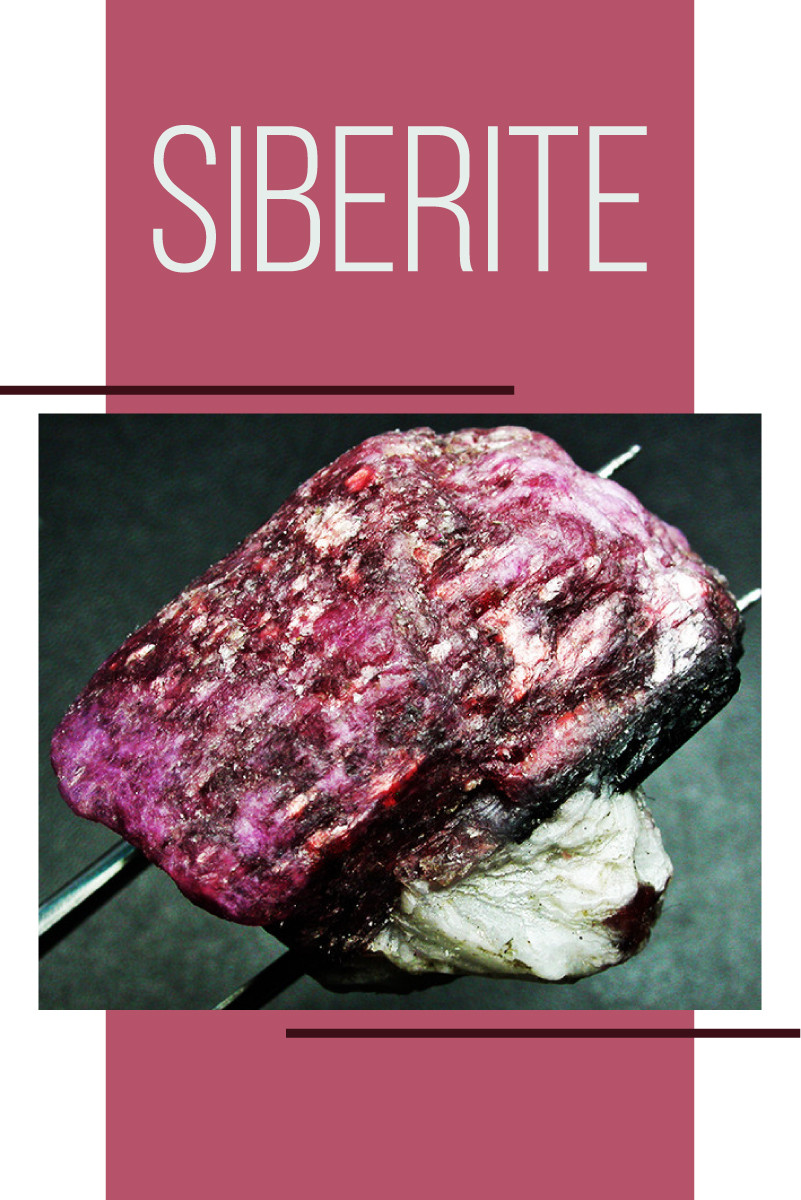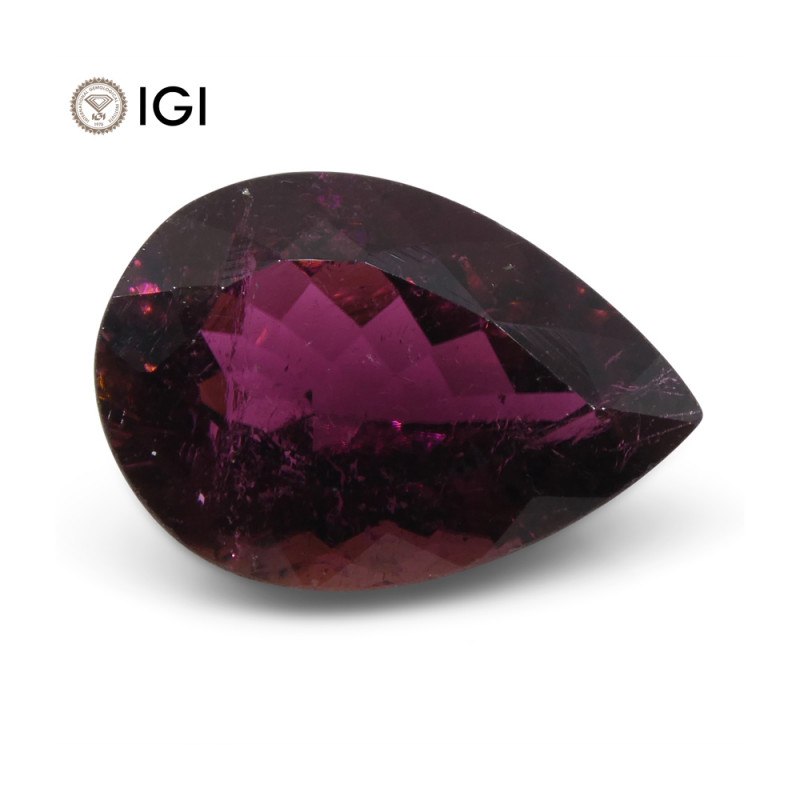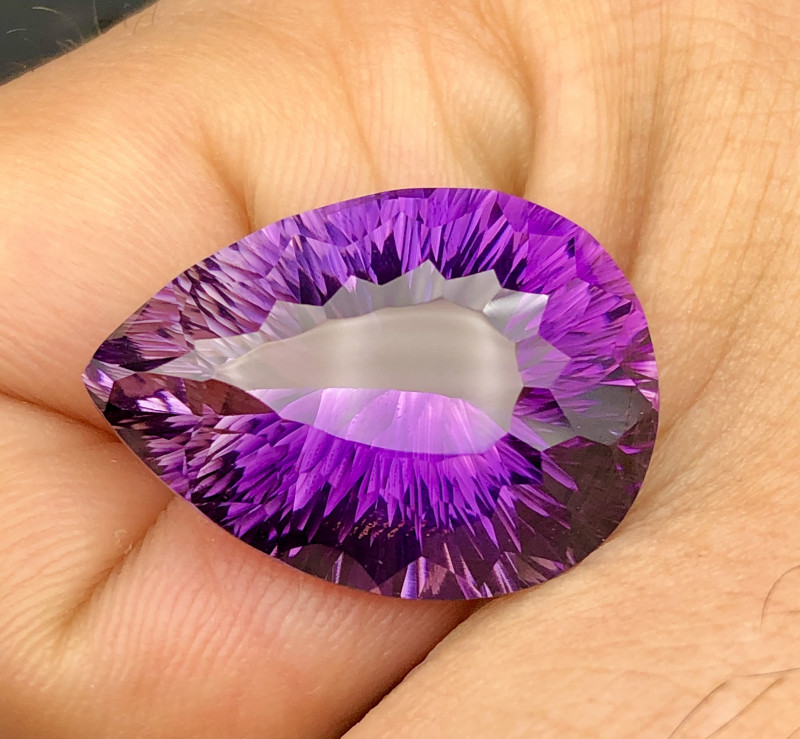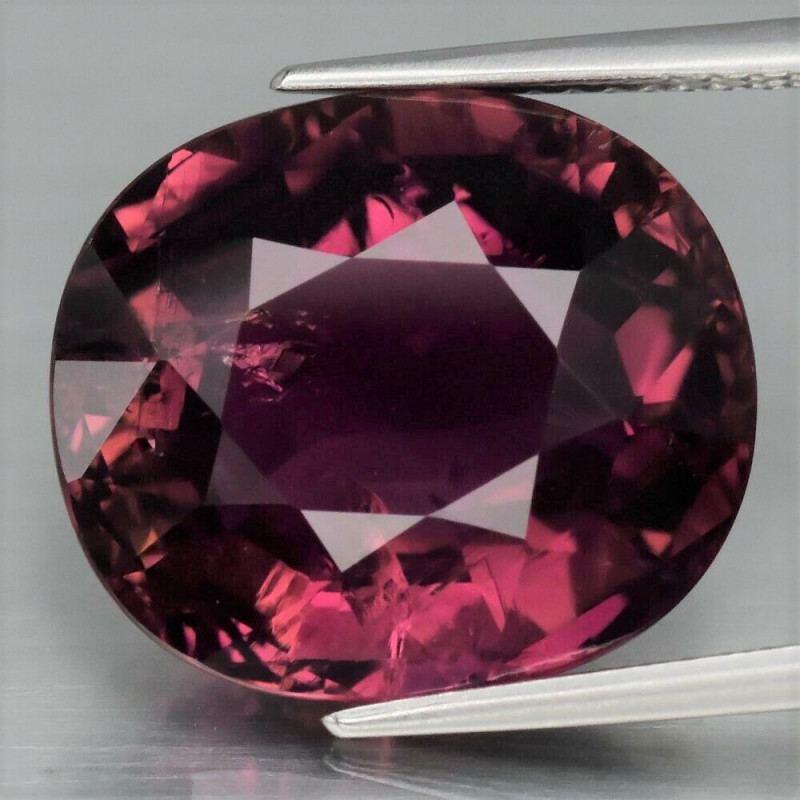
Siberite Gemstone: Nneɛma, Nkyerɛase, Botae & Nea Ɛkeka Ho
 Siberite yɛ aboɔden abo a wɔfrɛ no tourmaline a ɛyɛ violet, bruu, anaa kɔkɔɔ. Nnipa dodow no ara nim ahorow te sɛ Paraíba tourmaline anaa watermelon tourmaline yiye, bere a wonnim siberite tourmaline yiye saa.
Siberite yɛ aboɔden abo a wɔfrɛ no tourmaline a ɛyɛ violet, bruu, anaa kɔkɔɔ. Nnipa dodow no ara nim ahorow te sɛ Paraíba tourmaline anaa watermelon tourmaline yiye, bere a wonnim siberite tourmaline yiye saa.
Twɛn, dɛn ne tourmaline wɔ nea edi kan no mu? Tourmaline yɛ aboɔden abo abusua a ɛtrɛw a wɔtaa ka sɛ ɛno ne aboɔden abo kuw a ɛwɔ kɔla ahorow sen biara wɔ wiase (ɛwom sɛ ebia ebinom bɛka sɛ saa anuonyam yi kɔ fluorite so de).
Tuntum ne kɔla a wɔtaa de yɛ tourmaline, nanso kɔla bɛn na ɛntaa nsi wɔ tourmaline mu? Tourmaline ahorow a wɔntaa nhu ne Paraíba tourmaline, nanso nhwɛsode ahorow a ɛsakra kɔla ka tourmaline kɔkɔɔ, borɔdɔma, bruu, kɔkɔɔ, anaa kɔkɔɔ a ɛho tew ho nso ho yɛ na.
Afei, dɛn ne tourmaline a ɛyɛ kɔkɔɔ ? Ɛno ne nea yɛbɛbua nnɛ berɛ a yɛrekɔ tourmaline siberite a ɛyɛ kɔkɔɔ no so, abɔ ne agyapadeɛ, ne tumi, ne boɔ, ne nea ɛkeka ho ho nkɔmmɔ.

Dɛn Ne Siberite?
Siberite tourmaline yɛ aboɔden abo a ɛsom bo fã bi a wɔtaa frɛ no “turmaline kɔkɔɔ,” ɛwom sɛ ne kɔla taa dan kɔ kɔkɔɔ-violet anaa violet-kɔkɔɔ so de.
Sɛ́ tourmaline ahorow no, siberite yɛ October awobo , Venus nsoromma bo , ne atetesɛm mu ayeforohyia afe a ɛto so 8 abohene. Ɛwom sɛ tourmaline yɛ nsoromma mu hwɛ bo ma Libras de, nanso aboɔden abo a ɛyɛ kɔkɔɔ te sɛ siberite nso da Sagittarius tumi kɔla adi .
Maine, U.S.A., kuromfo nso betumi de tourmaline ahyɛ wɔn agyapade anuonyam, efisɛ ɛyɛ ɔman no aboɔden abo a aban de di dwuma fi 1977.
 Mfonini a ɛwɔ atifi hɔ no: Amethyst
Mfonini a ɛwɔ atifi hɔ no: Amethyst
Tourmaline a ɛyɛ kɔkɔɔ ne Amethyst
Sɛ wohwɛ a, ebia wobɛfrafra siberite ne amethyst . Nanso abo no yɛ soronko koraa. Nsonsonoe a ɛda abien no ntam ni:
Nnomaa ahorow : Siberite yɛ tourmaline ahorow, na amethyst yɛ quartz ahorow.
Nneɛma a ɛwɔ mu : Siberite yɛ sodium, lithium, aluminium, borosilicate aboɔden abo a ne nsusuwii yɛ Na(Li1.5Al1.5)Al6Si6O18(BO3)3(OH). Amethyst yɛ silicon dioxide (silica) aboɔden abo a ne nsusuwii yɛ SiO2.
Hardness : Siberite korɔn kakra wɔ Mohs mineral hardness scale so wɔ 7 kosi 7.5, bere a amethyst di kan wɔ 7.
Transparency : Bere a siberite betumi ayɛ nea ɛda adi no, ɛtaa yɛ opaque. Amethyst yɛ nea ɛyɛ hann kosi nea ɛda adi pefee.
Sɛ yɛhwɛ kɔla a, amethyst yɛ kɔkɔɔ bi bere nyinaa, nanso siberite nso betumi ayɛ bruu, pink, anaa kɔkɔɔ. Bio nso, amethyst kɔla kɔkɔɔ no fi abɔde mu mframa, dade/aluminum efĩ, anaa n’abien nyinaa mu; siberite kɔla kɔkɔɔ no fi manganese ne dade efĩ mu.
Siberite Nkyerɛkyerɛmu & Su ahorow
Tourmaline mineral kuw no yɛ nea ɛyɛ den, na ɛwɔ akuw nketewa ahorow ne ahorow bɛboro 30. Ɛno akyi no, tourmaline ahorow abiɛsa a ɛho hia wɔ hɔ a ɛsɛ sɛ wuhu: schorl, dravite, ne elbaite.
Aboɔden abo ho animdefo binom nso bu liddicoatite tourmaline ahorow no sɛ ɛho hia. Kan no na wobu liddicoatite sɛ elbaite bi kosii 1977 — nsonsonoe biako pɛ a ɛda wɔn ntam ne sɛ liddicoatite wɔ calcium a ɛhyɛ sodium ananmu. Ɛyɛ mmoa a wɔntaa nhu a wonim wɔn sɛ wɔtaa yɛ kɔla ahorow.
Schorl (black tourmaline) ne tourmaline a abu so sen biara, na ɛyɛ abɔde mu tourmaline nyinaa mu ɔha biara mu nkyem 95. Nanso, elbaite tourmalines ne ahorow a wɔtaa yɛ a ɛyɛ aboɔden abo .
Siberite yɛ elbaite tourmaline ahorow bi. Elbaite tourmalines afoforo bi ne:
Aboɔden abo ho animdefo binom bu siberite sɛ rubellite ketewaa bi, a ɛyɛ pink-kɔkɔɔ, kɔkɔɔ, anaa kɔkɔɔ-kɔkɔɔ ahorow.
Elbaite tourmalines te sɛ siberite taa yɛ sɛ anaa prismatic crystals a ɛwɔ afã 3, 6, 9, anaa 12. Wobetumi nso ayɛ sɛ ahwehwɛ a ɛyɛ acicular (te sɛ ade) anaa kurukuruwa a ne ntwemu yɛ ahinanan. Suban afoforo ne nea ɛte sɛ adum, botryoidal (ɛte sɛ bobe akuwakuw), anaasɛ aggregates a ɛhyerɛn, ne nneɛma a ɛyɛ compact.
Ebia siberite ahwehwɛ bi a wɔntaa nhu no wɔ rhombohedral awiei.
Ase hɔ no yɛ siberite a ɛwɔ mineral mu no din:
Mohs denden : 7-7.5
Kɔla : Bruu, violet, kɔkɔɔ, kɔkɔɔ-violet, pink, kɔkɔɔ
Ahwehwɛ nhyehyɛe : Ahinanan (afã abiɛsa) .
Luster : Vitreous (ahwehwɛ) anaasɛ resinous
Transparency : Ɛyɛ nea ɛda adi kɔsi nea ɛnyɛ hann, ɛtaa yɛ nea ɛnyɛ hann
Nneɛma a ɛma nneɛma yɛ mmerɛw : 1.614-1.666
Nnipa dodow : 3.02-3.26
Cleavage : Biara nni hɔ
Fracture : Ɛnyɛ pɛpɛɛpɛ/ɛnyɛ pɛpɛɛpɛ anaasɛ conchoidal ketewaa bi
Streak : Ɛyɛ fitaa
Luminescence : Biara nni hɔ
Pleochroism : Mprempren & ɛyɛ den, mpɛn pii no ɛyɛ kɔkɔɔ a ɛyɛ hann kosi kɔkɔɔ tuntum
Nsonsonoe abien : 0.014-0.024
Apete : 0.017 (ɛkɔ fam) .
Bere a yɛaka mineralogy no ho asɛm no, momma yɛnkɔ metaphysical fã no so bere a yɛrehwehwɛ siberite tourmaline ntease mu no.

Siberite Nkyerɛase & Abakɔsɛm
Sɛ wodi kan hwɛ tourmaline ɔbo no ntease a ɛwɔ hɔ nyinaa kan a, saa aboɔden abo yi yɛ ntease, ayamhyehye, ne adwene a wobue ho sɛnkyerɛnne. Wogyina hɔ ma nyansa ne adwene nso.
Dɛn na tourmaline kɔla ahorow no kyerɛ?
Colorless : Ahotew & awo foforo
Black : Grounding & ahobammɔ
Brown : Ahoɔden & ahoɔden a wɔde gyina ano
Red : Ahoɔden & akɔnnɔ
Pink : Ɔdɔ & tema
Orange : Adebɔ & charisma
Yellow : Anigye & nyansa
Green : Luck & anidasoɔ
Blue : Kommyɛ & ahotoso
Turmaline ahwehwɛ a ɛyɛ kɔkɔɔ no ntease yɛ ɔsoro nyansa, honhom fam nneɛma, ne ahosodi.
Wɔ Feng Shui, tete adwinni a ɛne sɛ ahoɔden a ɛsen fa nhyehyɛe a wosusuw ho yiye a atwa wo ho ahyia no mu kari pɛ mu no, tourmaline so wɔ mfaso ma yin ne yang ahoɔden a ɛkari pɛ. Wɔn a wɔyɛ adwuma no nso de tourmaline di dwuma de yɛ ahoɔden kyɛm de siw nneɛma bɔne ano.
Abakɔsɛm
Kyerɛwtohɔ a edi kan a ɛfa tourmaline a wohuu ho ne bere a Spainni nkonimdifo Francisco Spinoza huu tourmaline a ɛyɛ ahabammono wɔ Brazil wɔ 1554 mu, na mfiase no odii mfomso dii mfomso sɛ ɛyɛ emerald no. Nanso ɛbɛyɛ sɛ Dutch aguadifo fii ase dii tourmalines tuntum ho gua bɛyɛ 1400 mfe no mu, na wɔde wɔn magnetic ahoɔden no dii dwuma de yii nsõ fii wɔn nsu afiri mu.
Nea edi kan a wohuu siberite no mu nna hɔ, nanso mfitiase nhwɛsode ahorow a wɔyɛɛ mu nhwehwɛmu no fi Siberia, titiriw Bepɔw Soktuj. Siberia siberite nhwɛsode ahorow a Jean-Gabriel Caquet yɛe a wɔkyerɛwee bɛyɛ afe 1800 mu ho mfonini ahorow wɔ hɔ.
Edin “siberite” no fi Franse kasa mu sibérite , a ɛkyerɛ “ɔbo a efi Siberia.” Ebinom kyerɛkyerɛ siberite mu sɛ rubellite a efi Siberia.

Siberite Ayaresa Nneɛma
Te sɛ tourmalines nyinaa ne aboɔden abo nyinaa ne nyinaa no, wobetumi de siberite adi dwuma sɛ ɔbo a wɔde sa yare . Purple siberite ka aboɔden abo afoforo a ɛyɛ kɔkɔɔ ho de honhom fam nyansa ne nkate kɛse ba. Siberite a ɛyɛ kɔkɔɔ, te sɛ aboɔden abo kɔkɔɔ afoforo , ma ɛkanyan ne ahoɔden.
Nipadua mu Ayaresa
Crystal ayaresafo kamfo siberite kyerɛ sɛ wɔmfa nsa anaasɛ wɔmfa mmoa:
Asoroben
Nsa ne aniwa a ɛyɛ adwuma bom
Adwene a wɔde si biribi so
Nkwammoaa a ɛko tia nyarewa no dwumadi
Ɔhaw ahorow a ɛfa aduan a wɔyam ho
Vitality a ɛyɛ den
Atiridiinini a ɛyɛ hu
Wɔkyerɛ nso sɛ ahwehwɛ no ma amemene no fã a ɛwɔ benkum ne nifa no kari pɛ na ɛhyɛ nnompe mu den.
Nkate mu Ayaresa
Wɔ nkate fam no, wogye di sɛ siberite ma nea ɔhyɛ no nya kommyɛ, fam, ne ahomegye. Crystal ayaresafo kamfo ɔbo no kyerɛ sɛ ɛboa wo ma wugyae nkate mu nneɛma a ɛbata wo ho a mfaso nni so mma wo yiyedi no.
Bio nso, wɔkyerɛ sɛ siberite boa wo ma wo ho tɔ wo fi komayare, ahodwiriw, anaa awerɛhow mu. Ebia ɛbɛboa nso ama abufuw ano abrɛ ase na ama adwennwen atu mpɔn.
Chakra Ayaresa
Chakra ayaresa hwehwɛ sɛ wusiesie ahoɔden a ɛsen wɔ wo chakra ahorow (ahoɔden mmeae) no mu akwanside ahorow na ama nhyehyɛe no nyinaa asan ayɛ biako. Siberite yɛ chakra ɔbo ma aniwa chakra a ɛto so abiɛsa, a ɛwɔ wo moma so mfinimfini.
Aniwa chakra a ɛto so abiɛsa no na ɛkyerɛ honhom mu nhumu, nkate, ne wiase no ntease kwan. Sɛ wote nka sɛ woakɔda w’adwene mu anaasɛ wo ntam atwa a, ebia w’ani a ɛto so abiɛsa no besiw. Sɛ wode siberite bue mu a, ɛbɛboa wo ma woanya honhom fam nyansa kɛse.

Siberite Aboɔden Aboɔ Nneɛma a Ɛwɔ Hɔ
Siberite bo a ɛsom sɛ aboɔden abo no gyina ne kɔla, ne twitwa, ne sɛnea emu da hɔ so.
Ahosuo
Ɛmfa ho sɛ wonim no kɛse sɛ “purple tourmaline” no, siberite nso betumi ayɛ pink, bruu, kɔkɔɔ, anaa kɔkɔɔ ne violet a wɔadi afra. Kɔla a ɛyɛ pink kosi kɔkɔɔ fi manganese efĩ mu, bruu fi dade efĩ mu, na kɔla kɔkɔɔ fi abien no nyinaa a wɔadi afra mu.
Ebia Siberite aboɔden abo a ne kɔla yɛ bruu no soa bo a ɛkorɔn. Dichroism a emu yɛ den — a ɛkyerɛ kɔla ahorow abien a egyina sɛnea wɔhwɛ no so — nso som bo.
Twa
Esiane sɛ tourmaline nni cleavage na ɛwɔ hardness yiye nti, ɛkame ayɛ sɛ faceted cut biara betumi aba ama siberite. Ɛsɛ sɛ wotwa aboɔden abo a ɛwɔ dichroic denneennen te sɛ siberite a pon no ne axis no hyia na ama wɔada saa nkɛntɛnso yi adi yiye.
Faceted siberites bɛsoa boɔ a ɛkorɔn sen biara. Wɔtaa twa siberite nhwɛsode a ɛba fam sɛ cabochons anaasɛ wɔbɛtɔn a wɔantwitwa sɛ nhwɛsode a ɛyɛ mmerɛw.
Ɛda adi pefee
Clarity kyerɛkyerɛ dodow a nneɛma a wotumi hu a wɔde ka aboɔden abo mu ho. Purple elbaite tourmalines te sɛ siberite wɔ Type II kɔla aboɔden abo a emu da hɔ grade , a ɛkyerɛ sɛ wɔhwɛ kwan sɛ wɔde nneɛma nketenkete a wotumi hu bɛka ho.
Nneɛma bi a ebetumi de tourmaline aka ho ne:
Mpaapaemu atenten a ɛyɛ tratraa a gas ahyɛ mu ma a ɛma hann da adi
Nsu a ɛwɔ tokuru
Nnade a wɔde yɛ nneɛma
Kɔla ahorow a wɔde hyehyɛ mmeae ahorow
Siberites binom nso wɔ “floater” crystal inclusions wɔ mu. Mpɛn pii no, nneɛma a wɔde ka ho a wotumi hu bɛma aboɔden abo no bo akɔ fam.
Nneɛma a wɔde ka ho no kɔ aboɔden abo bi mu bere a wɔreyɛ no. Sɛ yɛreka ho asɛm a, ɔkwan bɛn so na siberite yɛ?

Siberite Formation & Nneɛma a Wɔde Yɛ Adwuma
Tourmaline ahwehwɛ te sɛ siberite nyin wɔ asase ase wɔ ogya abotan a wɔfrɛ no pegmatites mu. Bere a magma ma asase ase nsu yɛ hyew no, aboɔden abo afoforo tew kɔ nsu no mu na ano aduru no hyɛ mpaapaemu a ɛwɔ asase ase no ma. Nkakrankakra, saa ano aduru yi dwo na ɛyɛ ahwehwɛ ma ɛbɛyɛ tourmaline.
Sɛ manganese efĩ wɔ hɔ a, tourmalines a ɛyɛ pink betumi ayɛ. Dade efĩ betumi ama tourmalines a ɛyɛ ahabammono anaa bruu aba. Manganese ne dade efĩ ma tourmaline a ɛyɛ kɔkɔɔ.
Nea ɛnte sɛ aboɔden abo dodow no ara no, tourmaline tumi nyin bɛyɛ prism a ɛwɔ afã 3. Nea ɛka ho no, tourmalines binom yɛ hemimorphic, a ɛkyerɛ sɛ ɛsono sɛnea ahwehwɛ no atifi ne ase no te.
Mmeae a Wɔtu Tuo
Ɛhe na tourmaline a ɛyɛ kɔkɔɔ fi? Nneɛma a eye sen biara a wobetumi anya siberite ne Namibia ne Russia, titiriw Siberia. Nneɛma afoforo a wonya fi mu ne Nigeria ne Brazil.

Siberite Bo & Ne Bo
Siberite bo nyɛ den te sɛ tourmaline tuntum, nanso ne bo nyɛ den te sɛ Paraiba tourmaline.
Siberite aboɔden abo a ɛwɔ afã horow no bo bɛyɛ dɔla 30 kosi 460 wɔ carat biako mu wɔ kɛse mu anaasɛ $75 kosi bɛyɛ dɔla 1,170 biara.
Siberite cabochons taa gye dɔla 3.50 kosi 50 wɔ carat biara mu.
Ɛkame ayɛ sɛ bere nyinaa na siberite a ɛyɛ mmerɛw no nnu dɔla biako wɔ carat biara mu, anaasɛ emu biara bɛyɛ dɔla 20 kosi 50.
Siberite Hwɛ ne Nsiesiei
Nea eye ne sɛ, aboɔden abo a wɔde hwɛ siberite no yɛ nea ɛyɛ tẽẽ yiye. Ɔbo no nni cleavage planes a ɛbubu ntɛmntɛm na ɛwɔ hardness a ɛfata. Nanso, ebia wobɛpɛ sɛ wode nhyehyɛe ahorow a ɛbɔ wo ho ban ma siberite nkaa.
Wubetumi de brɔs a ɛyɛ mmerɛw, nsu a ɛyɛ hyew, ne samina a ɛnyɛ den asiesie siberite. Ɛtɔ mmere bi a, saa ahwehwɛ yi tumi yɛ nea ɛyɛ hyew, enti ma ɛntra ɔhyew a ano yɛ den ho na mfa nsie owia hann tẽẽ.

Woasiesie wo ho sɛ Wobɛfa Siberite Soar?
Ebia Siberite nyɛ tourmaline ahorow a wonim no yiye sen biara, nanso ɛnyɛ fɛ a ɛba fam sen tourmaline foforo biara. Ne su a ɛma obi dwo na ɛma nkurɔfo hu ade yiye no ma ɛyɛ ɔhokafo a ɔyɛ pɛ ma obiara a ɔrehwehwɛ mfaso horow yi — anaasɛ obiara a n’ani gye aboɔden abo a ɛyɛ fɛ a ɛyɛ kɔkɔɔ!
搜尋Gemstone Encyclopedia
相關拍賣
相關文章
Momma yɛnkyerɛkyerɛ sɛnea wɔtɔ aboɔden abo wɔ intanɛt so. Yɛwɔ aboɔden aboɔ a ɛso sen biara wɔ intanɛt so na ɛbɛtumi ayɛ den kakra wɔ mfitiaseɛ no. Ma yɛmfa afotu bi a mfaso wɔ so mmoa wo.
3rd Oct 2018
W’aboɔden abo a wobɛhwɛ so no boa ma ɛyɛ fɛ wɔ wo nkwa nna nyinaa mu. Yɛbɛka nneɛma te sɛ denden ne ayaresa ho asɛm, ne anammɔn a ɛfa sɛnea wobɛhohoro wo aboɔden abo na wode asie dwoodwoo ho.
9th May 2018
So woasusuw sɛnea wɔyɛ Ruby aboɔden abo ho pɛn? Ayaresa ahorow pii wɔ gua so na yɛbɛboa ma yɛakyerɛkyerɛ mu
9th May 2018
最新的文章
Nnua a wɔde asonse a wɔasen a wɔsan frɛ no nhabannuru asonse no yɛ abɔde mu ade a wɔde si asono asonse ananmu, na wotwa fi Amerika Kesee Fam phytelephas nnuadewa mu nnuadewa mu wɔ abrabɔ pa mu. Sua mmɛw asonse ho ade nyinaa wɔ akwankyerɛ yi mu!
15th Jan 2026
Chrysanthemum nhwiren abo yɛ abɔde mu anwonwade a ɛwɔ calcite, celestite, anaa andalusite nhwiren fitaa bi a wɔde asisi limestone tuntum anaa atɛkyɛ abo so.
13th Jan 2026
Rainbow lattice sunstone yɛ feldspar ahorow a ɛwɔ optical nsunsuanso abiɛsa fɛfɛ a efi nneɛma ahorow a wɔde ka ho a ɛwɔ hɔ no mu ba. Ɛyɛ ogya kɔla display ne lattice nsusuwso ma ɛyɛ coletor abohene a wɔntaa nhu!
12th Jan 2026
文章類別
How To's is where you will find helpful articles from gem Rock Auctions on how to cut gemstones, select gemstones and buy gemstones.
9文章




